We have moved to www.invisible-ireland.com
See this post and more at our new website!
I’ll continue with the theme of obelisks. Ok, Ok, Ok, I concur. It hardly counts as invisible or inconspicuous. It is 62m high and can been seen all around Dublin. It is the first thing people see exploring the Phoenix Park from the Islandbridge (City) entrance. It’s a major focal point as groups meet daily to play football or hangout in its shadow. This familiar towering obelisk dominated the footage of the 2014 Great Ireland Run on our TV screens yesterday.
The question is why is it there, hiding in plain sight?
Any major city worth is salt has an obelisk. Rio, London, Caracas, Jakarta, Yangon, Washington, Moscow and Maynooth. They are everywhere. Tapering four sided stone monuments. The word ‘obelisk ‘ is of Greek origin but the first actual obelisks where by none other than the Egyptians. Ramesses II said they would never catch on, the kids would find something new to chisel soon enough. Well they did catch on. The Romans actually loved them and subsequently stole most of them. They became hot property for expanding empires and Egyptian obelisks are now scattered to the four corners of the globe. By Egyptian definition, to be considered an obelisk one had to make it from a single piece of stone. Modern versions consider that a guideline rather than a rule, hence why they are considerably taller. The Egyptians had conceived the idea as a vessel to worship the Sun God Ra. This is also politely ignored by modern architects who copied the concept generally for war monuments and took their chances of enraging the Sun God. If Ra cared so much we might see him a little more around Ireland.
So if not built for Ra, then who is the Obelisk in Dublin built for?
The Phoenix Park Obelisk is called the Wellington Monument. It was designed by British architect Robert Smirke who made a significant contribution in shaping the face of London as we know it today. His LinkedIn profile can boast The British Museum, Convent Garden Theatre, Royal College of Physicians, Somerset House and numerous churches and stately homes. We can rest assured it was designed by one of the best; so it was designed for someone of considerable importance at the time. It took a staggering 44 years to build. This was not due to Robert Smirke trying to build it by himself but an issue with funds. Started in 1817 it was capped finally in 1861. Still beating the Washington Monument, the world’s largest, by 23 years as it only wrapped up construction in 1884.
The Wellington Monument commemorates the war victories of Arthur Wellesley, 1st Duke of Wellington or more popularly known as just the Duke of Wellington, the Iron Duke or just Dukey to friends. So why Dublin? Well Arthur was born in Dublin. More precisely at 6 Merrion Street according to his mother (others claim it to be 24 Merrion Street…..I’ll go with mother on this one, whats 18 doors between friends anyway). Actually the original plan was to build the monument in Merrion Square; until the neighbours realised they weren’t THAT proud of him. Educated at Eton, the Duke of Wellington went on to have a stellar military career with the British Army. I couldn’t even begin to document it here. Arthur fought the French in Holland, spent 7 years in India campaigning on multiple fronts, waged war on Denmark, again engaged the French on the Iberian Peninsula and upon retiring from military service he went on to become British Prime mister in 1828.
He has two achievements that stand out above all others. Firstly the music festival essential, the Wellington Boot was named after him. Arthur instructed his shoemaker, Hoby of St. James’s Street in London, to modify the 18th-century soldiers Hessian boot and make it waterproof. Wellington popularised this boot by modelling and wearing it. Think what Pamela Anderson did for Ugg boots.
His second achievement was being a General at the Battle of Waterloo, on those rolling plains 13km outside Brussels in Belgium. On Sunday 18 June 1815 Arthur Wellington went toe to toe with Napoleon Bonaparte for the first time. The battle was a complicated affair dominated by the battle hardened General’s strategies and tactics. As the day panned out the battle ebbed and flowed with decisive decisions still being debated to this day amongst military and leadership gurus.
To cut a long story short Napoleon lost. Badly. He lost more than just this battle. He was exiled to the tiny isolated Island of Saint Helena, located deep in the South Atlantic Ocean, over 1000km off Africa’s west coast to keep him out of trouble. He died here in 1821 while Wellington went on to be revered till his death in 1852.
Dublin’s Wellington monument has a little bit of Waterloo history attached to it. There are our bronze plaques on each side of the monument. These are actually cast from Napoleons captured cannons. So not only was the little General exiled but they melted down all his stuff to. Harsh. One of the plaques show his victory at Waterloo. Another shows the Indian Wars which where a huge part of his life.
The third plaque features Civil and Religious Liberty. Wellington in his political career introduced Catholic Emancipation; which granted almost full civil rights to Catholics in the UK. As you can imagine this went down well in Ireland.
The fourth and final side of this story has the inscription:
Asia and Europe, saved by thee, proclaim
Invincible in war thy deathless name,
Now round thy brow the civic oak we twine
That every earthly glory may be thine.


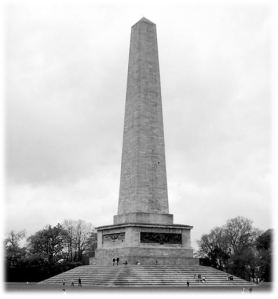


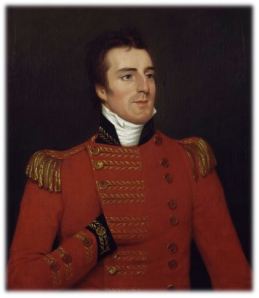

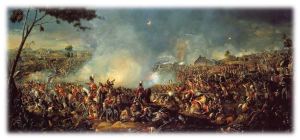

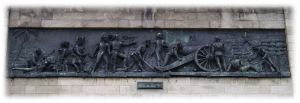
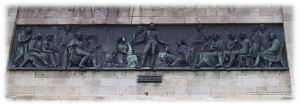

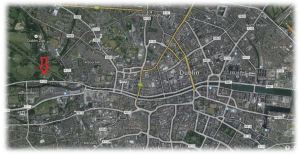

Excellent article, thank you 🙂